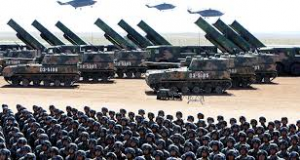(Editor’s Note: The Mad Scientist Laboratory is pleased to present the following guest blog post by Messrs. Jonathan D. Moyer, Alex Porter, and Christopher Rice. If you are interested in submitting a guest post, please select “Guest Bloggers” from the menu above)
 Foresight, or humans’ ability and inclination to think about and plan for an uncertain future, is crucial to our survival and progress as a species. Foresight is an innately human activity and our ability to engage in foresight is, arguably, what sets us apart from other species. We make decisions based on assumptions and observations about how the world around us might unfold every day.
Foresight, or humans’ ability and inclination to think about and plan for an uncertain future, is crucial to our survival and progress as a species. Foresight is an innately human activity and our ability to engage in foresight is, arguably, what sets us apart from other species. We make decisions based on assumptions and observations about how the world around us might unfold every day.
The future is fundamentally unknowable, and often the unforeseen is more shocking and disruptive to our lives than the foreseen. However, the discourse around the future often focuses on the changes we can’t foresee – financial crashes, epidemics – so-called “black swans” or “wild-cards.”  In reality, our human experience is characterized much more by continuity than by change. Physical laws are stead-fast and human activities, social norms and stocks of technology change slowly. The sun will rise tomorrow morning, networks of languages and communication will remain intact, institutions of governance will persist, and we will drive to work following shared traffic norms.
In reality, our human experience is characterized much more by continuity than by change. Physical laws are stead-fast and human activities, social norms and stocks of technology change slowly. The sun will rise tomorrow morning, networks of languages and communication will remain intact, institutions of governance will persist, and we will drive to work following shared traffic norms.
Analysts should be equipped with tools to help decision-makers better understand the current trajectory of development across issue areas (what will the world look like in 2035-50?) and what kinds of choices we can make today to get to a more optimal future.
The Pardee Center employs the International Futures (IFs) integrated forecast system, a public and freely available long-range forecasting platform, to think about and analyze possible futures across hundreds of issue areas. The IFs tool brings together a range of analytic approaches to thinking about the future to produce dynamic, integrated forecasts of possible futures.
 IFs analysis begins with the “Current Path” of development. The IFs tool produces forecasts for key variables across issue areas – agriculture, demographics, economics, education, environment, governance, health, infrastructure, international politics – for 186 countries. The Current Path is a dynamic and integrated forecast that represents a continuation of current policy choices and environmental conditions across these issue areas. It includes variables ranging from global population to country-level power
IFs analysis begins with the “Current Path” of development. The IFs tool produces forecasts for key variables across issue areas – agriculture, demographics, economics, education, environment, governance, health, infrastructure, international politics – for 186 countries. The Current Path is a dynamic and integrated forecast that represents a continuation of current policy choices and environmental conditions across these issue areas. It includes variables ranging from global population to country-level power
indices, military spending,  and multi-dimensional state fragility (developed as part of a four year grant from the Department of Defense Minerva research initiative).
and multi-dimensional state fragility (developed as part of a four year grant from the Department of Defense Minerva research initiative).
Understanding the Current Path of development is a starting point, but framing the uncertainty inherent in forecasts requires scenarios. Quantified scenarios tell integrated stories about how the future is likely to unfold while also setting reasonable expectations for the impact of policy interventions. This approach has contributed to analyses by the United Nations, the European Union, the National Intelligence Council, the U.S. Agency for International Development, the U.S. Army, and numerous other international government and industry organizations.
The IFs tool can be used to examine trends and impacts in and across areas and that are of interest to the Deep Future Operational Environment. For example, we can create scenarios that frame the long-term impacts of evolving power generation and storage technology on political and economic relations. Or we can examine the long-term impacts of shifting demographic trends and urbanization on the global labor force, infrastructure provision, and social dynamics. Further, recent modelling efforts at the Pardee Center have focused on incorporating trends and impacts of artificial intelligence and attempting to forecast the broader economic and social impacts of climate change. 
The persistent problem of planning for an uncertain future characterizes decision-making across all large organizations. There is no panacea for solving this “problem of the future”, but the IFs tool can help analysts and policy-makers make better informed decisions in the face of great uncertainty. The tool can be used or downloaded from the Pardee Center website.
For more information regarding the IFs and its application in identifying future trends, please see Dr. Jonathan D. Moyer’s presentation on Long Term Trends and Some Implications of Decreasing Global Interdependence, from the Strategic Security Environment in 2050 Conference at Georgetown University, 8-9 August 2016.
Dr. Jonathan D. Moyer is Assistant Professor at the Josef Korbel School of International Studies at the University of Denver and Director of the Frederick S. Pardee Center for International Futures.
Alex Porter is a research consultant at the Frederick S. Pardee Center for International Futures.
Dr. Christopher Rice is the Deputy Director of the US Army Future Studies Group.



The overall aspect of the blog reminded me of two things: 1) when there was a Joint Forces Command they published a product known as the JOE (Joint Operating Environment https://fas.org/man/eprint/joe2010.pdf) that looked to the future and focused on socio-cultural attributes; not as detailed as the IFs model but looked globally for strategic level planning and communication at the Combatant Command (and above) levels. Seem to remember it running annually from 2007-2010 and there was a complementary CJCS document called the Capstone Concept for Joint Operations (CCJO). Appears the JOE continues in form and function (see: http://www.airuniversity.af.mil/Portals/10/CMSA/documents/Required_Reading/Joint%20Operating%20Environment%202035%20The%20Joint%20Force%20in%20a%20Contested%20and%20Disordered%20World.pdf).
2) The IFs reminds me of the Lockwood Analytical Method for Prediction (LAMP) I used during my Masters work at American Military University (AMU). Very manual looking at a number of potential alternate futures to answer specific questions “…Using primarily qualitative empirical data, LAMP allows the analyst to predict the most likely outcomes for specific research questions across a wide range of intelligence problems…” https://www.bloomsbury.com/us/the-lockwood-analytical-method-for-prediction-lamp-9781623562335/. My class was 10 years ago that I used this method and it resulted in my LAMP Paper being identified as Great Student Paper in 2007 at AMU.
I’m not sure where you are getting your information, but good topic.
I needs to spend some time learning much more or understanding
more. Thanks for fantastic information I was looking for this info for my mission.
Way cool! Some very valid points! I appreciate you writing this write-up
and also the rest of the site is also very good.